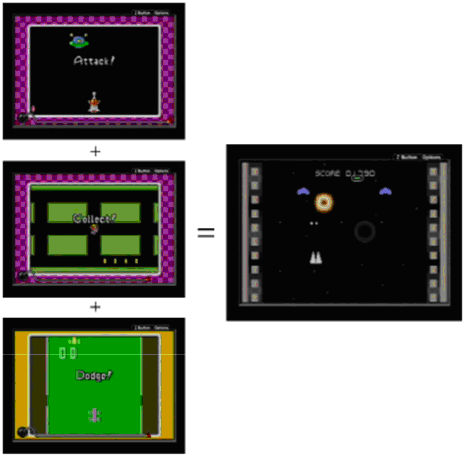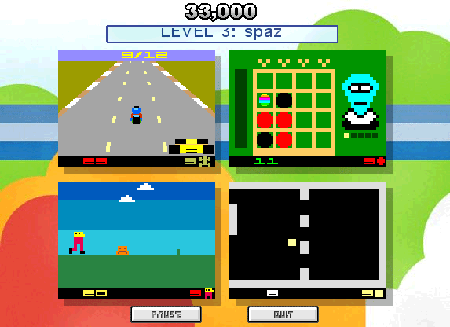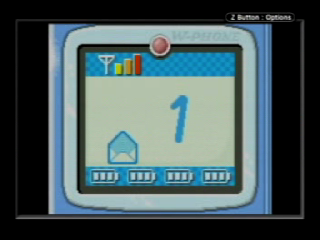Chaim Gingold is a game designer on Spore, Will Wright’s current project at Electronic Arts/Maxis. He has a masters degree from Georgia Tech's Information Design & Technology program. His masters thesis, Miniature Gardens & Magic Crayons: Games, Spaces, & Worlds , analysed the work of master game designers Will Wright and Shigeru Miyamoto.
What
WarioWare can teach us about Game Design
Chaim Gingold reviews WarioWare.
Nintendo: WarioWare Inc.: Mega MicroGame$. Nintendo R&D1 2003. (Gameboy Advance).
Introduction
The story: Wario, realizing there is lots of money to be made in video games, decides to found his own game company. The resulting game: Play through a rapid-fire series of bizarre micro games. Each WarioWare level consists of 24 micro games, each about 5 seconds in length.
Wario
Ware is a game about games. Some of its micro games are straight
re-implementations of earlier Nintendo classics, but WarioWare
also parodies older games such as Super Mario Bros[7]. and The
Legend of Zelda[8]. WarioWare exhibits and distorts many
game design conventions we take for granted. The Dungeon Dilemma game
at the end of the Orbulon level, for example, seems to adhere to the
conventions of a computer role playing game, but something is off:
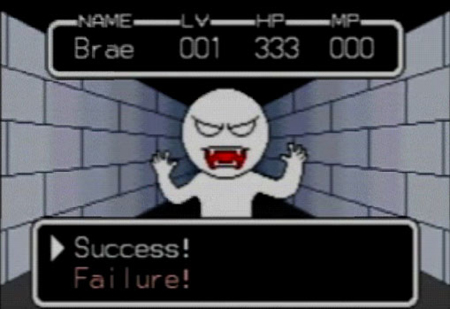
The menu system looks like a computer role playing game interface, but the menu options, “success” and “failure”, are not be found in a genuine RPG. The conventions of a RPG have been transformed into an action game: the cursor moves between menu items on its own accord, and you have to push the button to stop it at the right option. WarioWare is crammed full of parody, subversion, and quotation of game clichésand conventions. WarioWare plays with game design idioms, and in doing so foregrounds game conventions. As a result, WarioWare has a great deal to teach us about game design.
WarioWare's most obvious departure
from conventional game design is its discontinuities, which
illustrate the effects of continuity on game experience. Wario
Ware's ultra-compressed games contain only a minimum number of ingredients. These
miniature games illustrate how complex games are generally built out
of simpler ones. WarioWare’s nonsense and absurdities
also explore the relationship between fiction and rules.
In
a sense, WarioWare is an Understanding Comics[4] of video games:
a text that uses the representational strategies of a medium to
reflect upon that same medium. But where Understanding Comics
is discourse on comics, written in the language of comics, Wario
Ware is more like Chuck Jones's meta-cartoon Duck Amuck[2].
WarioWare and Duck Amuck violate convention, and in
doing so draw attention to how cartoons and games are both
constructed and interpreted.
Continuity
Just as a micro game starts to make sense, it ends, and you are dropped into an altogether new game. Micro games last about 5 seconds, so you must quickly figure out what game is being played, what you're supposed to do, and how you do it. WarioWare's discontinuities point to how continuity is usually used to create coherent and playable games.
A video game is a world with its own fiction, nouns, verbs, goals, and
controls. An unstable fiction makes interpreting goals and controls
confusing. Part of the cognitive friction WarioWare creates
by changing games so fast, is that you can't map nouns and verbs from
one game to the next. One game may contain a snowboarder, and you
figured out that by pushing left and right on the directional pad you
could guide her through a gate, but the next game has no snow
boarder, gate, or even snow.
It is often unclear what state of
affairs you want to bring into being. These are games, after all, and
in games you have to accomplish some goal, otherwise you lose. Wario
Ware helps us out by labelling micro games as they start. Stomp!,
Avoid!, and Collect! are examples of such labels, but they are often
little more than vague clues as to what you need to do, or how you do
it.
The next problem is figuring out how to affect the world
on your screen. How do the Game Boy Advance buttons map to actions in
the game world? In one game left and right on the directional pad map
to the left and right motion of an object, but in the next game
they'll do nothing, and the A button will cause a needle to punch
into a disc and stop its rotation.
These surprises highlight
the cognitive benefits of playing in a consistent world. They also
tell us something about the role of the player character. Sometimes a
WarioWare micro game will start, and I'll understand the
fiction, goal, and controls, but fail to map myself into the right
object. My goal is to keep a creature under a spotlight, and I often
guess incorrectly as to whether my directional buttons move the
spotlight or the creature. If I were consistently mapped to a
particular character, such as Mario, there would be no such
confusion. Player characters organize controls, goals, and fiction
into consistent and coherent bundles. When I'm playing Super Mario
Bros., I understand that as Mario, my inputs always affect Mario,
my goals are the same as Mario's, and that Mario, who looks like a
man, is probably affected by gravity and sharp objects. When the
world or player character aren't radically transforming, and retain
their form over time, goals and controls remain coherent over
time.
Scale
Every
medium has its short form. We have examples of short films, music,
and written stories. WarioWare demonstrates the ultra-short
form of video games: the five second micro game. What happens when
the size conventions of video games are pushed to their limit?
Wario
Ware's micro games are carefully bounded in several dimensions.
First, the space in which these games are played is tiny. Most of
them occupy a non-scrolling space the size of a Game Boy Advance
screen. Second, the time allotted for each micro game is short.
Third, the goal you have to accomplish is incredibly simple: collect
these coins, walk to that goal, or push the A button at the right
moment. Lastly, the input mechanisms are simple. There are no triple
jumps or back flips to master. Most games use only the A button for
player input, and many others use only the left and right directional
buttons.
By pushing the formal boundaries of game complexity
to a bare minimum, WarioWare foregrounds the essential
elements of what makes a video game a video game. Once you've taken
out everything you can in order to make the smallest video games
possible, what's left over? WarioWare's micro games seem to say:
- Fiction. Examples: I'm a lizard and I eat things; I'm a man and can walk; I'm a race car that races; I'm a hand and can grab things that are falling.
- Goal. Examples: Catch!, Jump!, or Avoid!
- Agency. Examples: Push the A button to catch, stop, or move something.
This list of minimal features more or less maps to Jesper Juul's definition of a game [10]. The elements all these games have, something that Juul’s doesn't, is fiction. The fictions that WarioWare's micro games present are critical to understanding micro game goals, and to the overall aesthetic. Wario Ware is fun and comprehensible in spite of its discontinuities precisely because of its fictional representations. But how else does WarioWare help us make sense of its chaos?
Sense and Nonsense
What
prevents WarioWare, with all its formal experimentation, from
degenerating into unplayable chaotic nonsense? Why does WarioWare
make any sense at all?
First, the simplicity of each
micro game means it can be rapidly learned and tuned into. If I were
suddenly dropped into a random moment of Final Fantasy 7[11] for
three seconds, I would probably fail. WarioWare's
micro games, on the other hand, are so simple in terms of fiction,
goal structure, and agency, that they are quickly grasped.
Another
component of WarioWare's playability is that you've played
all these micro games before, or something like them. Sometimes you
literally play another game, such as F-Zero[6]. Other times, the
micro game is an analogue, as in Collect!, where you maneuver a
character through a maze to collect coins. The meta-game of Wario
Ware is identifying the game on the screen, and mapping it to
your knowledge of video games. Broad knowledge of video games makes
you a better WarioWare player.
Finally, clear and
consistent boundaries mark the discontinuities between micro games.
WarioWare uses a highly stylised animation to mark the ends
and beginnings of micro games. The most confusing moments, the
transitions between games, are carefully called out. In fact, more
visual and aural jazz happens between the micro games than in the
micro games. Drawing attention to the boundaries that separate
micro games helps us tune out of one game and into the next. One can
imagine how rearranging a game with only subtle transition cues ways
would be far more confusing. I'm playing Super Mario Bros.,
and with no transition to mark it, the coins have become poisonous,
and Mario is invincible in the face of all enemies. The results would
be disastrous. Making the discontinuities bigger makes them more
obvious, and harder to trip over.
Building Blocks
Clearly marked game boundaries, and the micro-scale of each game, bring the atomicity of each game to the foreground. The micro games are short, small, and simple, and the boss games, by comparison, are long, big, and complex. Boss stages and micro games, however, share many game design elements. Galaxy 2003, the boss at the end of Dribble's level, seamlessly integrates the earlier micro games Shoot!, Avoid!, and Collect!. Galaxy 2003 is a conventional overhead scrolling shooter: players shoot at enemies, avoid colliding with them, and collect power-ups. Boss games, it seems, are compound collections of micro games.
The Galaxy 2003 boss game is made of the micro games Attack!, Collect!, and Dodge!.
If
we take a series of micro games and dissolve their boundaries, we end
up with a WarioWare boss game. These boss games are more or
less equivalent to complete, modern games. Galaxy 2003, for instance,
is a structurally complete overhead shooter. WarioWare
demonstrates how complex games can be built out of simple
components.
This building block structure is also evident in
other games. Super Mario Bros., for example, can be decomposed
into WarioWare sized micro games. Shooting enemies,
collecting coins, entering pipes, dodging enemies, stomping enemies,
and leaping across chasms are all micro-activities inside of Super
Mario Bros.. Most of these micro-activities, in fact, appear in
WarioWare as micro games.
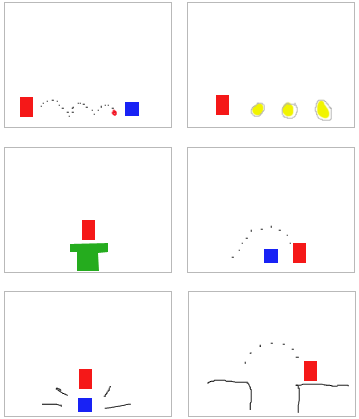
Author’s illustration of Super Mario Bros.’s micro-activities decomposed into WarioWare sized micro games: Shooting fireballs, Collecting coins, Entering pipes, Dodging enemies, Stomping enemies, and Jumping over holes.
How are micro games synthesized into bigger games? Are there any patterns or regularities in how games integrate their building blocks into new wholes? Gamelab's Arcadia[3], like WarioWare, is a game built out of clearly demarcated micro games:
Arcadia, by gameLab.
Wario
Ware and Arcadia unify their sub-games differently. In
WarioWare, component games come one after the other,
separated in time, but occupying the same space. Arcadia's
micro games happen at the same time, but occupy different spatial
frames. Most games, such as Super Mario Bros. and Wario
Ware's bosses, ask players to do multiple activities
simultaneously, and overlap their component games in both time and
space.
Let's look at how WarioWare recursively
decomposes into its component games from the top down. WarioWare
is unified by the fiction that Wario has made a game company, and you
are playing his games. To beat the game, you must complete each level
in sequence.
Each level of WarioWare is integrated by
a fiction, such as playing a bunch of cell-phone games, or escaping
from the police:
The cell phone fiction that unifies the micro games of the “Jimmy” level.
These
fictions, however weak, thematically unify a level. To complete a
level, players must win a sequence of micro games. Sequencing
micro games and giving the player a goal of working through the
entire sequence, gives each level a unified win-condition. To lose a
level, players fail to finish four micro games, which creates a
unified failure state. The end of each level is marked with a boss,
which frames each level as a whole.
As discussed earlier, each
boss is a tightly integrated set of micro games. While each level of
WarioWare combines its component games sequentially, the
bosses integrate sub-games through simultaneity. In the Galaxy 2003
shooter boss, for example, players juggle dodging enemies, shooting
enemies, and collecting power-ups. WarioWare bosses unify
their component micro games by making the player balance simultaneous
activities. Like the multiple chances players get within a level,
players get often get multiple chances within a boss game. These
chances, however, take a different form. In Galaxy 2003, your space
ship evolves as you collect power-ups, and devolves as you take
damage. In the Punch-Out boss at the end of Jimmy's level, each blow
you take depletes one of your hearts.
This structural stance,
imagining games as collections of permutable components, leads us to
some interesting places. First, by decomposing games into their
component parts and then comparing those pieces, we have a basis for
comparing complex games. Reversal, for example, is an activity that
happens in both Pac-Man[5] and Super Mario Bros. Pac-Man's
power pellet, which reverses the chase relationship between Pac-Man
and the ghosts, is isomorphic to the invincibility star of Super
Mario Bros. The importance of such an analytical approach has
been argued for by Doug Church [1].
By adding a historical
dimension, one could map out a family tree of games. This would
reveal how game designers have parsed the structure of earlier games,
and reused those pieces. Thinking of games as unified strands of
discrete forms would let us understand how game designs are
recombined, inherited, and mutated over time.
Fiction & Rules
The fictions of WarioWare's games are diverse, to say the least. This is another domain in which WarioWare breaks rules. Wario Ware is filled with bizarre and rapidly shifting fictions like sniffing mucus, brushing teeth, walking on whales, and keeping cats out of the rain.
As
a set of design decisions, the relationship between fiction and rules
in WarioWare is quite interesting. Since fiction in Wario
Ware seems to have so much free play with respect to game rules,
we should be able to learn something about the necessary and optional
linkages between fiction and rules. When is fiction free to be
nonsensical, and when must it firmly connect to rules?
The
relation between fiction and rules on each level ranges from
disconnected to connected. Jimmy's cell-phone level is a workable
fiction for understanding the rules that links its micro games: each
game is a cell phone game. Others fictions are total disconnects from
the level mechanics. Dr. Crygor's level marks the transition between
games with a zooming into and out of a high-tech toilet bowl. Lives
are represented as rolls of toilet paper. Both the connected and
disconnected fictions, however, thematically unify each level and
strongly mark the transitions between micro games. When moving from
game to game, two fictional breaks occur: once, as we pop out from
our last micro game into the level fiction, and again as we push into
a new micro game. Nonsense is just as good as sense for signalling
the switch between micro-worlds.
While the fiction for a
particular game may seem arbitrary, the relationship between each
game's fiction and its rules is not. If the fiction of The Brush Off,
where players move a toothbrush back and forth over a mouthful of
teeth, was changed to a map of Denmark moving back and forth over a
bumblebee, that game would be less playable. A goal state (it is
desirable to clean dirty teeth), controls (usually one drives the
toothbrush, not the teeth), and inputs (left and right, aligned with
the direction and location of the toothbrush), are all immediately
communicated by the fictional representation. Not only that, but
playing a toothbrushing game is silly and fun. While entertaining
and outrageous, WarioWare's micro game fictions are strongly
linked to rules.
The level fictions, by not fictionally
integrating the micro games, reinforce each micro game's
separateness, and promote the idea that we must come to terms with
each micro game on its own. Even the cell-phone fiction, the most
coherent of all the connecting level fictions, reinforces each game's
separateness, as each game is represented as a new email on your cell
phone. The micro game fictions, by closely integrating with their
rules (toothbrushes clean teeth; men in karate outfits chop wood
blocks), accelerate our comprehension of each game. If one were to
break the coherency between each micro game's fictions and rules,
WarioWare would be unplayable, because it demands rapid
recognition and comprehension of micro games.
WarioWare's
diverse fictional strategies explore and demonstrate the free play
between fiction and rules available to game makers. In some ways,
fiction is arbitrary, and nonsense can even be used to enhance
usability. While fiction has a certain amount of free play, it is
ultimately grounded in a need to explicate rules. By pushing
fictional possibility to its limits, WarioWare demonstrates
how ludicrous game fictions can get, while reminding us of the
symbiotic relationship between rules and fiction.
Conclusion
In
terms of game design, WarioWare is a very interesting game.
It pushes the boundaries of game size and complexity, the speed at
which we can adapt to new games, and game fictions, to the breaking
point. Through these formal experiments, WarioWare
demonstrates how complexity can be achieved through combining
micro games into bigger games, the range of free play between fiction
and rules available to designers, and the role of continuity in
games.
WarioWare, finally, is fascinating because of
its message to game scholars: we can reflect upon games by making
them. Experimental games are a powerful tool for thinking about and
communicating ideas about games.
Bibliography
[1]
Church, Doug, "Formal Abstract Design Tools." Gamasutra,
July 1999.
[2] Duck Amuck. Director: Chuck M. Jones. Warner
Bros, 1953. 7 minutes.
[3] GameLab, Arcadia. 2002.
Shockwave game. http://www.gmlb.com/games/arcadia.html
[4]
McCloud, Scott. Understanding Comics. New York:
HarperPerennial, 1994.
[5] Namco, Pac-Man. 1981. Arcade
game.
[6] Nintendo, F-Zero. Nov. 1990. Super NES
game.
[7] Nintendo, Super Mario Bros. Sept. 1985. NES
game.
[8] Nintendo, The Legend Of Zelda. 1987. NES
game.
[9]
Nintendo, WarioWare, Inc: Mega Microgames. 2003. Game Boy
Advance game.
[10] Juul, Jesper. Half-Real: Video Games
Between Real Rules And Fictional Worlds. PhD dissertation, IT
University of Copenhagen, October 2003.
[11] SquareSoft, Final
Fantasy VII. Sony Computer Entertainment America, 1997.
PlayStation game.
